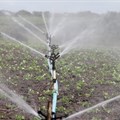In 1938, French colonial authorities in what is today Mali started on an ambitious infrastructure plan to transform the desert into an area of agricultural production. Water was diverted from the Niger River through a canal system to enable irrigation on over one million hectares of fertile land. Eventually covering over 100,000 hectares, this project is still one of the largest irrigation schemes in Africa.

Image source: Gallo/Getty
The Malian project, known as “Office Du Niger”, has had a profound influence on agricultural water management and planning across Africa since the mid-20th century. By the 1960s, African governments saw it as a model for rural development.
With World Bank funding, hundreds of dams and large irrigation schemes were set up across Africa. The intended goals were increasing food security, reducing poverty, and stimulating economic growth. Unfortunately, the reality of many of these irrigation projects has been quite different.
Since 2008, in response to rising food prices, governments across Africa have announced plans for a new era of irrigation scheme development. Yet, it remains unclear why earlier schemes fell so short of expectations. To answer this question, we evaluated the performance of 79 schemes constructed across Sub-Saharan Africa between the 1940s and 2010.
Our research reviewed original targets for agricultural production areas, as reported in project planning documents. These were compared with estimates of how much irrigated land projects currently support. The estimates were derived from high-resolution satellite imagery.
Our findings show that these irrigation schemes deliver on average only 18% of the irrigated production area they originally propose. And many schemes are now completely inactive – some only a few years after construction. There appears to be little evidence of scheme performance improving over more than 60 years.
Cycle of failure
Research on individual schemes has blamed a number of factors for irrigation project failures. These include scheme size and climate. Arguing that larger schemes that experience more variable climates fail more often. This was largely not the case in our analysis of 79 projects.
Instead, we found the main causes of failure to be political and management frameworks underpinning irrigation project development.
First the political. For governments, a key motivation for scheme development was to produce more food. This would also reduce dependence on imports while generating exports. But the resulting focus on production of low-value staple crops – such as rice and maize – often led to poor financial performance.
Low-value crops undermine the financial sustainability of capital intensive irrigation projects in the long term. This is because these crops don’t always generate reliable and substantial profits from land allocated within schemes. And that makes it harder for farmers to contribute to the maintenance and upkeep of infrastructure.
The result is a cycle of dependence on external investment and subsidies. Once this initial investment runs out, many schemes deteriorate rapidly.
Second, donors have tended to prefer large, centrally-managed infrastructure projects. They seem to be less complex technically and logistically than a multiplicity of smaller scale initiatives. Unfortunately, many centralised government agencies in Sub-Saharan Africa are underfunded and poorly resourced. Many lack the technical and institutional capacity needed to manage such large-scale projects.
At the same time, donor preferences for scale stimulate government appetite for optimistic plans to tap financial support. As a result, proposed irrigated areas and scheme returns are often unrealistic. For example, the Office Du Niger only recently achieved 10% of the 1 million hectares planned in 1938. On the other hand, schemes designed to irrigate 127,000 hectares around Lake Chad are now completely inactive.
Planners, too, understate costs and overstate benefits. Our research argues that without changes to the way projects are envisaged, implemented and managed, African governments risk repeating mistakes of the 20th century development. This could have damaging consequences for poverty, food security and economic development.
Ways forward
Failures of large-scale irrigation in Sub-Saharan Africa have been acknowledged for several decades. But our research suggests that this has had little impact on the way planners or governments approach such projects.
Given actual outcomes achieved, it is arguable that many large-scale irrigation projects have not delivered a return on investment. Even those that were initially viable have since gobbled up funds for maintenance and rehabilitation. Greater and more systematic monitoring and accounting of performance is needed to address these issues.
To do this, governments, donors and researchers can use new data sources such as satellite imagery. Just as important are reforms to planning processes to ensure investments are made contingent on successful and sustainable outcomes for farmers and communities.
In parallel, we also suggest a rethink of the historical preference for large projects. Are they the best or only means of increasing either food security or farmer incomes?
There is a growing recognition that farmers across Africa are highly entrepreneurial. This is evidenced, for example, by the recent increase in focus within the World Bank and other agencies on farmer-led irrigation. Small-scale farmers have for many decades and even centuries been developing a wide range of irrigation systems independent of development agencies or governments.
Evidence suggests that these investments may be several orders of magnitude cheaper than large schemes. These may offer better returns in terms of farmer incomes and rural livelihoods.
Continuing investment
Investments in large-scale water infrastructure will continue to an important means of agricultural production. This is more so as water availability becomes increasingly erratic in many regions due to climate change and pressures from population growth.
This calls for investments in storage infrastructure – both built and natural – to ensure reliable access to water. This in turn provides a basis for encouraging farmers to invest in irrigated agriculture, thus reducing risks associated with adoption of new technologies or practices.
This also calls for new approaches to how irrigation development is financed and implemented in Africa. There’s a need to combine both large and small scale approaches to irrigation development to meet the twin goals of improving food and water security.
This article is republished from The Conversation under a Creative Commons license. Read the original article.



























